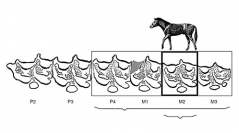

 Geodiversitas
25 (2) - Pages 321-345
Geodiversitas
25 (2) - Pages 321-345A new approach of reconstructing ungulate diets, the mesowear method, was introduced by Fortelius & Solounias (2000). Mesowear is based on facet development on the occlusal surfaces of the teeth. Restricting mesowear investigation on the M2 as has previously been suggested would limit application of the mesowear methodology to large ungulate assemblages. Most of the fossil, subfossil and recent ungulate assemblages that have been assigned to a single taxon have a smaller number of individuals. This results in the demand to extend the mesowear method to further tooth positions in order to obtain stable dietary classifications of fossil taxa. The focus of this paper is to test, if a consistent mesowear classification is obtainable for the remaining positions of the upper cheek tooth dentition (P2, P3, P4, M1 and M3) and for combinations of these tooth positions. For statistical testing, large assemblages of isolated cheek teeth of the Vallesian hipparionine horse Hippotherium primigenium Meyer, 1829 and of two populations of the recent zebra Equus burchelli Gray, 1824 are employed as models. Subsequently, all single cheek tooth positions and all possible combinations of these tooth positions are tested for their consistency in classification of the mesowear variables compared to the M2, the model tooth of Fortelius & Solounias (2000). As the most consistent model for the proposed "extended" mesowear method, the combination of four tooth positions P4, M1, M2, and M3 is identified, which allows to include the largest number of isolated tooth specimens from a given assemblage, and fulfills the demand of being consistent in the dietary mesowear classification with the "original" mesowear method. We propose the "extended" mesowear method to be particularly well suited for the reconstruction of paleodiets in hypsodont equids.
Equidae, Hippotherium, Equus burchelli, mesowear method, methodology, paleodiet, paleobiology, paleoenvironment